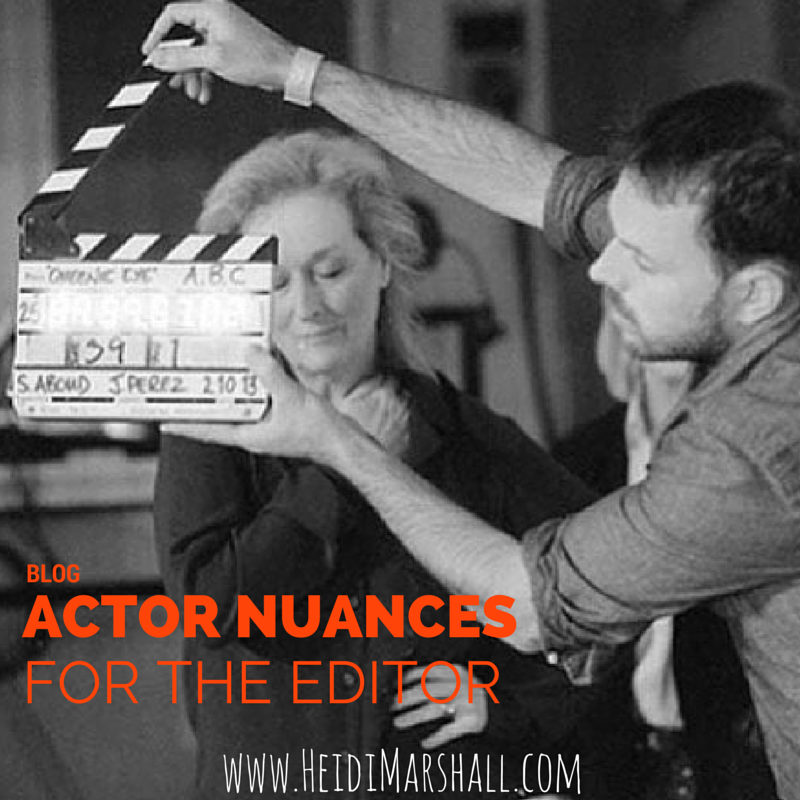Subscribe – Button
Get Tips
Get free tips while you’re waiting to jump into a class! Sign up for my newsletter.

Here are TWO ACTING TIPS on how to give a stellar performance to an Editor.
Yes, only 2 tips!
Of ALL of the things that I talk about in classes these are the two most important foundation principles that I work from with all actors. After filming recently, I’m even more convinced that they will serve you beautifully when you are working on set.
I always say in my classes: “Why do each Take exactly the same? Directors and Editors want and need variety in your acting choices in the editing room! Please give us options when we are editing!!!”
Did you know that there are 1,540,577 ways to say “I love you”?
My friend was Script Supervisor for a film starring Meryl Streep. I remember her saying that the most amazing thing was that every single Take by Streep was completely different from the last one. She described the awe of watching Streep explore the range of nuances for every scene, every line.
One delivery of a line versus another delivery of the same line, can totally alter the story or the scene. Your nuances will give depth to the character and the story.
Yes, Streep has the emotional capacity to give varying performances, and so do you. The variety of nuances is gold to an Editor and Director. They can then sculpt your talent into an amazing performance.
Every Take needs to be nuanced differently from the previous take so that they have options later in the editing room.
Keep evolving your choices, don’t get stuck on trying to do it the exact same way each time.
Evolve. Explore. Discover.
Be conscious of the character’s arc while filming each individual scene. A clear character arc is one of the greatest contributions you can make to the shaping of a film.
Think about the journey of the story and how your character changes from start to finish. Start there and build your choices.
If your character doesn’t go on a journey, then the film doesn’t go on a journey.
When you do a stage play, don’t you think about arc? When you start doing run-thrus, you become acutely aware of how one scene builds and links to another. You are very conscious of your character’s arc.
Craft a character arc in film, just like you do in theater.
What makes it interesting for the audience to watch your character? The promise of change.
The movie Girl Gone is an excellent example of conscious character arc choices. If Ben Afleck and Rosamund Pike didn’t carefully plot out their arc choices, the plot twists wouldn’t have worked!
Even every Romantic Comedy has to have an arc, right? The main characters need to discover real love! The bachelor man needs to give up his bachelor ways. The single woman needs to let down her guard. The end won’t have the same impact if you don’t set up the opposite at the beginning of the story!
Prepare your arc from your first scene all the way to the final scene.
It will take some time and attention to plan out your arc.
Track your character arc in your own private preparation of the role. No matter the Director’s involvement with your acting choices, you can be the actor who is thoughtfully prepared about your character arc.
I wish for you that you get to work with a Director who LOVES to talk about character. And if not, walk onto those sets prepared to make strong choices to help the story unfold.
Give acting nuances in every take, plus an arc in the whole film, and then I’m sure that your Editor and Director will LOVE you when putting the puzzle together in the editing room.
In classes, I simulate the audition room as the context of your acting because it’s where you get to actually practice all of these onset acting tips.
Auditioning is a place to practice delivering what will be needed from you when acting on set.
Every audition, practice 1)doing nuanced and different takes and 2)creating arc within every audition scene.
Every scene can be done a million different ways and every scene has an arc.
Shape your work and the Editor and Director will be praising you in the editing room!
Fred Berman says
Great stuff, Heidi. Always enjoy reading your insights. Hope you’re well, and congrats on the film!
Andrew David Rabensteine says
Always great to read your thoughts on the various aspects of the process. This was interesting to me, not just as an actor, but also because I’m about to direct and edit my own webseries in the fall. I’m sure I’ll be coming back to this blog post again and again as I get ready to shoot it. Thanks for sharing!
Evangelia Kingsley says
Thanks for this two-part blog entry. Really interesting and thought provoking. Can’t wait to hear all about the film!